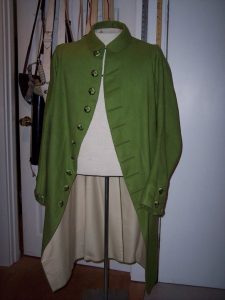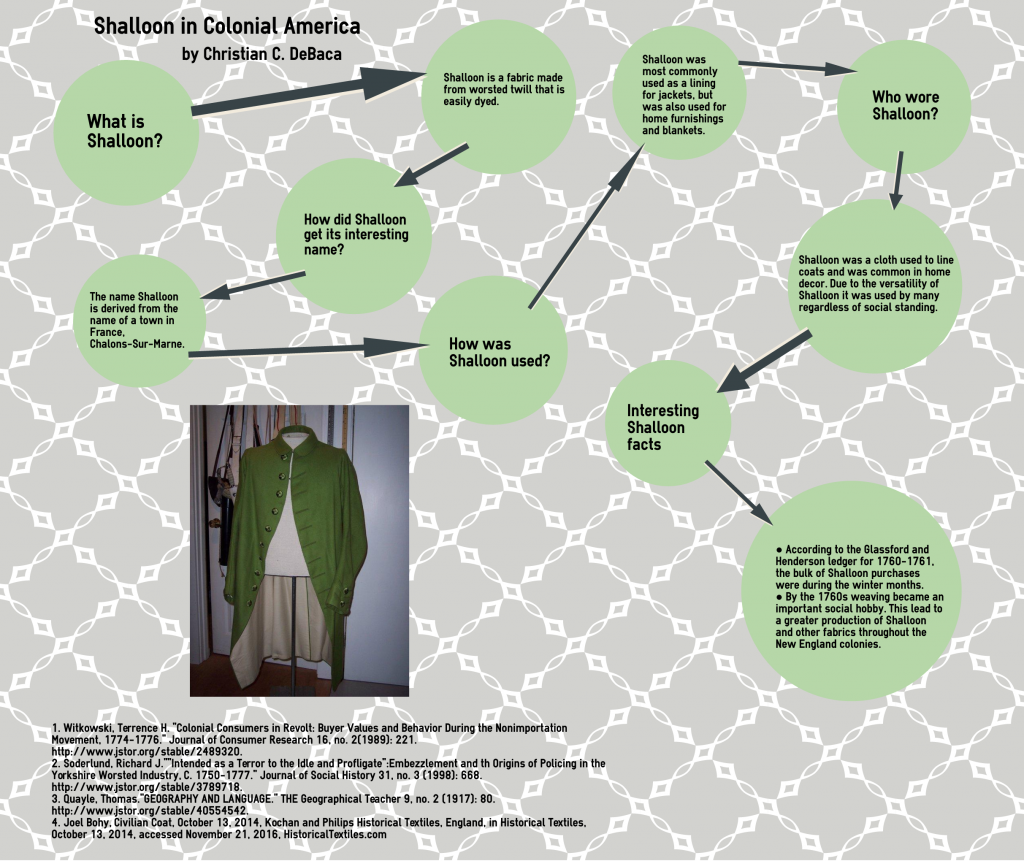Shalloon Useful and Unknown
Christian C.deBaca // AMH 4112.001 – The Atlantic World, 1400-1900
Shalloon, a fun name to come across when learning about life in colonial Virginia, but what is it?
As found in the Glassford & Henderson 1760-1761 ledger at the Colchester, Virginia store on January 16, 1761, Humphrey Peake purchased 9 yards of Shalloon along with various other fabrics, buttons, and thread.[1] Based on the associated items and its unit price, one could assume that Shalloon was a type of cloth.

What type of cloth was shalloon? Did it have a specific function? Who were the general consumers of it? Shalloon was a common fabric in the 18th century that was a thin twill, made of worsted wool, and primarily used for the lining of coats. When considering that it was used for the lining of coats, it comes as no surprise that it was not a common purchase, unless you were crafting your own clothing or needed to replace the lining of your existing coat. The author J. H. Clapham states that Shalloon was a fabric that was worn “by the lower classes of females” but it was also widely used in coats of all demographics including military uniforms.[2] Since Shalloon was not thought of highly, it was affordable, while still not the cheapest fabrics. At the same time, shalloon was known for its versatility and relative ease in dyeing, making it a fashionable choice of cloth for everyone. Not only was shalloon used for clothing, it was also sometimes used in blankets and things like curtains or for the drapery around beds.
As found in the ready money account and personal accounts in the ledger, shalloon was sold as a raw material typically bought in small quantities along with other clothing related items. In the Ready Money accounts, of the seven purchases of shalloon, the length of fabric purchased ranged from ½ yard to 5 ½ yards. It is possible that by comparison, Humphry Peake may have been a tailor, given his purchase was for 9 yards of shalloon. The sale of shalloon seemed to peak during the winter months when production and need for coat linings would have been at its highest.
Shalloon was a cloth common because it could be used relatively cheaply to line coats. With that being said, shalloon was not as commonly purchased as other fabrics, such as linen.
Shalloon was not a cloth that was often exclusively used to make clothing. It stayed relevant for the colonial period due to its multiple uses for home décor and its ability to be dyed easily for custom work.

[1] Alexander Henderson, et. al. Ledger 1760-1761, Colchester, Virginia folio 97 Debit, from the John Glassford and Company Records, Manuscript Division, Library of Congress, Washington, D.C., Microfilm Reel 61 (owned by the Mount Vernon Ladies’ Association).
[2] J.H. Clapham. “The Transference of the Worsted Industry from Norfolk to the West Riding.” The Economic Journal 20, no. 78 (1910): 199. doi:10.2307/2220916.
